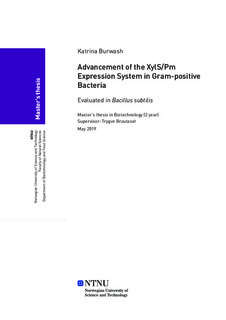| dc.description.abstract | Escherichia coli (E. coli) is one of the best characterized prokaryotes and therefore one of the most popular hosts used for heterologous protein expression. Today, the XylS/Pm expression system is predominantly used in E. coli, however, there are some disadvantages when using E. coli as a host for recombinant protein expression; such as poor protein secretion into the extracellular medium. An advantage that gram-positive bacteria have is that they are able to secrete proteins straight into the culture medium. In this study, advancement of the XylS/Pm expression system was evaluated in B. subtilis.
In previous work, it was shown that there was no XylS detected from its native promoters, Ps1 and Ps2 and was identified as one of the bottlenecks. After changing the original promoters to native B. subtilis promoters and codon optimizing XylS, it led to successful XylS production but still no mCherry production from Pm. Currently, this expression system is still not functional in B. subtilis and the potential bottleneck is now thought to be the production of the target protein, mCherry, from Pm.
It was hypothesized that the coexpression of E. coli sigma factors may facilitate the expression of the target protein, mCherry. Sigma factor production of σ32 and σ38 that were being expressed from PliaI in constructs pMSM67.4 and pMSM69.4 was verified through western blotting, however, when mCherry fluorescence was measured post induction, there was no detectable signal. A qPCR analysis was performed for the relative quantification of mCherry transcript from Pm, where it was shown that there was a significant fold change between the induced cultures of pMSM67.4 and pMSM67, also between pMSM69 and pMSM67, which showed increased levels of mCherry transcript, however, not between pMSM69.4 and pMSM69. Finally, after running protein sequence alignments it was discovered that there was very little similarity between both the sigma factors and RNAP core enzymes of B. subtilis and E. coli.
It was concluded that the coexpression of sigma factors had a positive effect on the levels of mCherry transcript, as did expressing higher levels of XylS, however, there was not an additive effect when sigma factors were combined with higher levels of XylS as was seen between pMSM69.4 and pMSM69, with still no detectable mCherry fluorescence signal. Looking at the sequence analyses there could still be bottlenecks at the transcription initiation level due to not only σ32 and σ38 being unrecognizable by B. subtilis RNAP, but also the interactions of XylS with the RNAP α-subunit, which are both required for transcription from Pm. | |
